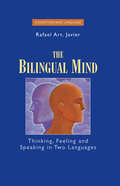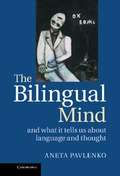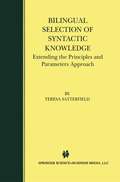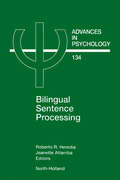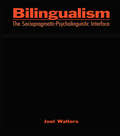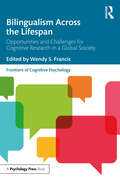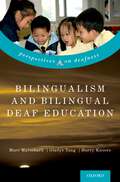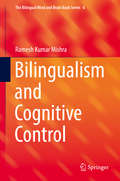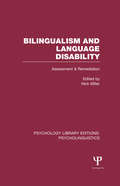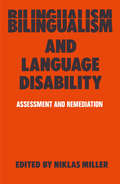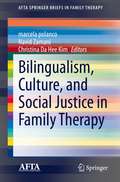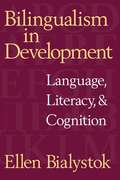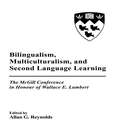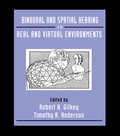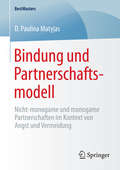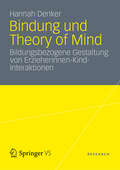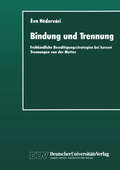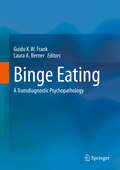- Table View
- List View
The Bilingual Mind: Thinking, Feeling and Speaking in Two Languages (Cognition and Language: A Series in Psycholinguistics)
by Rafael Art JavierThis book fills a critical gap in the cross-cultural literature by illuminating the bilingual experience in both its social and clinical contexts. Rafael Javier makes a convincing, empirically founded case for what he terms the bilingual mind, with its own particular approach to cognition, memory, and emotional and social development. Using this framework, he provides answers to important questions about the way bilingualism affects cognition and development.
The Bilingual Mind (PDF): And What It Tells Us About Language And Thought
by Aneta PavlenkoIf languages influence the way we think, do bilinguals think differently in their respective languages? And if languages do not affect thought, why do bilinguals often perceive such influence? For many years these questions remained unanswered because the research on language and thought had focused solely on the monolingual mind. Bilinguals were either excluded from this research as 'unusual' or 'messy' subjects, or treated as representative speakers of their first languages. Only recently did bi- and multilinguals become research participants in their own right. Pavlenko considers the socio-political circumstances that led to the monolingual status quo and shows how the invisibility of bilingual participants compromised the validity and reliability of findings in the study of language and cognition. She then shifts attention to the bilingual turn in the field and examines its contributions to the understanding of the human mind.
Bilingual Selection of Syntactic Knowledge: Extending the Principles and Parameters Approach
by Teresa SatterfieldBilingual Selection of Syntactic Knowledge motivates a more formal approach in theoretical linguistics by investigating the parameters of syntactic variation and simultaneous acquisition of multiple languages. Taking the behavior of the Null Subject Parameter (NSP) across languages as an illustration, the book raises important questions concerning the adequacy of standard parameter-setting models in the face of compelling evidence from both mono- and bilingual child speech data. Teresa Satterfield argues convincingly that so-called `universal' premises guiding well-known parametric approaches greatly complicate attempts to construct an economical bilingual analysis. Further, she demonstrates the compatibility of more recent formulations in linguistic theory (i.e. the Minimalist Program) and studies on language learnability (Clark, 1992, 1993; Kapur, 1994) which present the view that while initially convincing, standard parameter models are potentially costly and less than effective in terms of monolinguals as well. Using Clark's application of the Genetic Algorithm as a point of departure, Bilingual Selection of Syntactic Knowledge describes a number of computational simulations. These simulations not only demonstrate the robustness of the GA-as-language-learner, they offer a more detailed account of the parameter-setting task confronting the bilingual child while also making more precise predictions regarding the process of syntactic knowledge.
Bilingual Sentence Processing (ISSN #Volume 134)
by Roberto Heredia J. AltarribaBilingual Sentence Processing
Bilingualism: The Sociopragmatic-Psycholinguistic Interface
by Joel WaltersIn the past 30 years, the study of bilingualism processing has been conducted independently by two fields, psycholinguistics and sociolinguistics. This volume merges these two fields, addressing one of the tough problems dividing researchers in bilingualism, conceptually as well as methodologically. Joel Walters proposes a new approach to bilingualism processing--the Sociopragmatic-Psycholinguistic (SPPL) Model--which presents language as a social phenomenon. The author accomplishes this by identifying and organizing evidence from a wide range of linguistic disciplines, merging sociopragmatics, discourse analysis, and ethnography with social cognition, psycholinguistics, and neuroscience. By extension, the author offers convincing explanations of how related fields can profit from a comprehensive bilingual processing model. As a result, Joel Walters delivers a well-organized, comprehensive model that is thought through at every level. This book appeals to graduate students, scholars in the fields of linguistics, bilingualism, second language acquisition, psycholinguistics, and sociolinguistics. It is useful to researchers for its comprehensiveness and methodological acumen and may be appropriate as a supplementary textbook for graduate-level courses in bilingualism or for seminars on similar topics.
Bilingualism: The Sociopragmatic-Psycholinguistic Interface
by Joel WaltersIn the past 30 years, the study of bilingualism processing has been conducted independently by two fields, psycholinguistics and sociolinguistics. This volume merges these two fields, addressing one of the tough problems dividing researchers in bilingualism, conceptually as well as methodologically. Joel Walters proposes a new approach to bilingualism processing--the Sociopragmatic-Psycholinguistic (SPPL) Model--which presents language as a social phenomenon. The author accomplishes this by identifying and organizing evidence from a wide range of linguistic disciplines, merging sociopragmatics, discourse analysis, and ethnography with social cognition, psycholinguistics, and neuroscience. By extension, the author offers convincing explanations of how related fields can profit from a comprehensive bilingual processing model. As a result, Joel Walters delivers a well-organized, comprehensive model that is thought through at every level. This book appeals to graduate students, scholars in the fields of linguistics, bilingualism, second language acquisition, psycholinguistics, and sociolinguistics. It is useful to researchers for its comprehensiveness and methodological acumen and may be appropriate as a supplementary textbook for graduate-level courses in bilingualism or for seminars on similar topics.
Bilingualism Across the Lifespan: Opportunities and Challenges for Cognitive Research in a Global Society (Frontiers of Cognitive Psychology)
by Wendy S. FrancisBilingualism Across the Lifespan explores the opportunities and challenges that are inherent in conducting cognitive research in an increasingly global and multilingual society. Divided into three sections, the book highlights the multifaceted and complex nature of bilingualism. The first section focuses on what every cognitive psychologist ought to know about bilingualism: the impact of bilingualism on cognition across the lifespan, the idea that bilinguals are not a special case, and the importance of bilingualism in cognitive research beyond language. The second section focuses on challenges inherent in bilingual research: diversity of bilingual experience, the assessment of proficiency, and finding matched comparison groups and materials. Finally, the book considers opportunities that are created when bilingualism is incorporated into the cognitive research enterprise. It illustrates how researchers of bilingualism leverage theory, methodology, and findings from single-language research, incorporate uniquely bilingual processes or representations, and target populations of bilinguals that help to establish universal properties. Bringing together leading international contributors, the book provides the reader with a better understanding of the nature of bilingualism and bilingual research as it relates to human cognition. It will be an essential read for all researchers and upper-level students of bilingualism and cognitive psychology more generally.
Bilingualism Across the Lifespan: Opportunities and Challenges for Cognitive Research in a Global Society (Frontiers of Cognitive Psychology)
by Wendy S. FrancisBilingualism Across the Lifespan explores the opportunities and challenges that are inherent in conducting cognitive research in an increasingly global and multilingual society. Divided into three sections, the book highlights the multifaceted and complex nature of bilingualism. The first section focuses on what every cognitive psychologist ought to know about bilingualism: the impact of bilingualism on cognition across the lifespan, the idea that bilinguals are not a special case, and the importance of bilingualism in cognitive research beyond language. The second section focuses on challenges inherent in bilingual research: diversity of bilingual experience, the assessment of proficiency, and finding matched comparison groups and materials. Finally, the book considers opportunities that are created when bilingualism is incorporated into the cognitive research enterprise. It illustrates how researchers of bilingualism leverage theory, methodology, and findings from single-language research, incorporate uniquely bilingual processes or representations, and target populations of bilinguals that help to establish universal properties. Bringing together leading international contributors, the book provides the reader with a better understanding of the nature of bilingualism and bilingual research as it relates to human cognition. It will be an essential read for all researchers and upper-level students of bilingualism and cognitive psychology more generally.
Bilingualism and Bilingual Deaf Education (Perspectives on Deafness)
by Marc Marschark, Gladys Tang and Harry KnoorsIn Bilingualism and Bilingual Deaf Education, volume editors Marc Marschark, Gladys Tang, and Harry Knoors bring together diverse issues and evidence in two related domains: bilingualism among deaf learners - in sign language and the written/spoken vernacular - and bilingual deaf education. The volume examines each issue with regard to language acquisition, language functioning, social-emotional functioning, and academic outcomes. It considers bilingualism and bilingual deaf education within the contexts of mainstream education of deaf and hard-of-hearing students in regular schools, placement in special schools and programs for the deaf, and co-enrollment programs, which are designed to give deaf students the best of both educational worlds. The volume offers both literature reviews and new findings across disciplines from neuropsychology to child development and from linguistics to cognitive psychology. With a focus on evidence-based practice, contributors consider recent investigations into bilingualism and bilingual programming in different educational contexts and in different countries that may have different models of using spoken and signed languages as well as different cultural expectations. The 18 chapters establish shared understandings of what are meant by "bilingualism," "bilingual education," and "co-enrollment programming," examine their foundations and outcomes, and chart directions for future research in this multidisciplinary area. Chapters are divided into three sections: Linguistic, Cognitive, and Social Foundations; Education and Bilingual Education; and Co-Enrollment Settings. Chapters in each section pay particular attention to causal and outcome factors related to the acquisition and use of these two languages by deaf learners of different ages. The impact of bilingualism and bilingual deaf education in these domains is considered through quantitative and qualitative investigations, bringing into focus not only common educational, psychological, and linguistic variables, but also expectations and reactions of the stakeholders in bilingual programming: parents, teachers, schools, and the deaf and hearing students themselves.
Bilingualism and Bilingual Deaf Education (Perspectives on Deafness)
by Marc Marschark Gladys Tang Harry KnoorsIn Bilingualism and Bilingual Deaf Education, volume editors Marc Marschark, Gladys Tang, and Harry Knoors bring together diverse issues and evidence in two related domains: bilingualism among deaf learners - in sign language and the written/spoken vernacular - and bilingual deaf education. The volume examines each issue with regard to language acquisition, language functioning, social-emotional functioning, and academic outcomes. It considers bilingualism and bilingual deaf education within the contexts of mainstream education of deaf and hard-of-hearing students in regular schools, placement in special schools and programs for the deaf, and co-enrollment programs, which are designed to give deaf students the best of both educational worlds. The volume offers both literature reviews and new findings across disciplines from neuropsychology to child development and from linguistics to cognitive psychology. With a focus on evidence-based practice, contributors consider recent investigations into bilingualism and bilingual programming in different educational contexts and in different countries that may have different models of using spoken and signed languages as well as different cultural expectations. The 18 chapters establish shared understandings of what are meant by "bilingualism," "bilingual education," and "co-enrollment programming," examine their foundations and outcomes, and chart directions for future research in this multidisciplinary area. Chapters are divided into three sections: Linguistic, Cognitive, and Social Foundations; Education and Bilingual Education; and Co-Enrollment Settings. Chapters in each section pay particular attention to causal and outcome factors related to the acquisition and use of these two languages by deaf learners of different ages. The impact of bilingualism and bilingual deaf education in these domains is considered through quantitative and qualitative investigations, bringing into focus not only common educational, psychological, and linguistic variables, but also expectations and reactions of the stakeholders in bilingual programming: parents, teachers, schools, and the deaf and hearing students themselves.
Bilingualism and Cognitive Control (The Bilingual Mind and Brain Book Series #6)
by Ramesh Kumar MishraThis thought-provoking monograph makes a multidisciplinary case for bilingualism as a possible enhancer of executive function, particularly cognitive control. Its central focus is the cognitive operations of the bilingual brain in processing two languages and whether they afford the brain a greater edge on neuroplasticity—in short, a cognitive advantage. Major issues and controversies in the debate are analyzed from cognitive neuroscience, psycholinguistic, and integrative perspectives, with attention paid to commonly and rarely studied domains at work in bilingual processing. The author also pinpoints future areas for improved research such as recognizing the diversity of bilingualism, not simply in languages spoken but also in social context, as seen among immigrants and refugees. Included in the coverage: The evolution of bilingualism.What goes on in a bilingual mind? The core cognitive mechanisms.Cognitive advantage of bilingualism and its criticisms.Neuroscience of bilingualism.Bilingualism, context, and control.Attention, vision, and control in bilinguals. With its cogent takes on ongoing questions and emerging issues, Bilingualism and Cognitive Control is of immediate interest to bilingual researchers and practitioners interested in understanding the behavioral aspects and neurobiology of bilingualism and the dynamic character of the bilingual/multilingual/second language learner’s mind, as well as the growing number of advanced undergraduate and graduate students interested in the psychology/psycholinguistics of bilingualism, bilingual cognitive psychology, cognitive science, and cognitive neuroscience.
Bilingualism and Language Disability: Assessment and Remediation (Psychology Library Editions: Psycholinguistics)
by Nick MillerSociety is becoming increasingly multi-lingual and this presents monolingual professionals, particularly those in special education and speech pathology, with severe problems. Is the language delay in a child from a bilingual environment a result of this background or is there a specific speech problem? Is a child’s poor performance in school due to his problems of coping with two languages, or does he need remedial teaching? Originally published in 1984, this book is not concerned with second language learning, but with speech and learning difficulties in bilingual children as they are presented to remedial teachers, psychologists and speech therapists. To this end the first group of specially written articles deals with the patterns of language usage in bilingual communities and the social and psychological factors which shape these patterns; with processes in normal bilingual language acquisition; and with the relationship between cognitive development and growing up with two languages. Management issues and methods involved in helping children with language problems are also tackled: they include taking case histories, family liaison, counselling, bilingual programmes, mother tongue teaching, curriculum development and the training of personnel to work in the bilingual-bicultural field. This book provided a great deal of practical help, in a field that was relatively new at the time of writing, and helped to enlighten readers on the issues involved and assist in crystalising thought and directing future research.
Bilingualism and Language Disability: Assessment and Remediation (Psychology Library Editions: Psycholinguistics)
by Nick MillerSociety is becoming increasingly multi-lingual and this presents monolingual professionals, particularly those in special education and speech pathology, with severe problems. Is the language delay in a child from a bilingual environment a result of this background or is there a specific speech problem? Is a child’s poor performance in school due to his problems of coping with two languages, or does he need remedial teaching? Originally published in 1984, this book is not concerned with second language learning, but with speech and learning difficulties in bilingual children as they are presented to remedial teachers, psychologists and speech therapists. To this end the first group of specially written articles deals with the patterns of language usage in bilingual communities and the social and psychological factors which shape these patterns; with processes in normal bilingual language acquisition; and with the relationship between cognitive development and growing up with two languages. Management issues and methods involved in helping children with language problems are also tackled: they include taking case histories, family liaison, counselling, bilingual programmes, mother tongue teaching, curriculum development and the training of personnel to work in the bilingual-bicultural field. This book provided a great deal of practical help, in a field that was relatively new at the time of writing, and helped to enlighten readers on the issues involved and assist in crystalising thought and directing future research.
Bilingualism, Culture, and Social Justice in Family Therapy (AFTA SpringerBriefs in Family Therapy)
by Marcela Polanco Navid Zamani Christina Da Hee KimThis volume advocates for justice in language rights through its explorations of bilingualism in family therapy, from the perspectives of eighteen languages identified by the authors: Black Talk/Ebonics/Slang, Farsi, Fenglish, Arabic, Italian, Cantonese Chinese, South Korean, Mandarin Chinese, Vietnamese, Spanish, Chilean Spanish, Mexican Spanish, Colombian Spanglish, Madrileño Spanish, Spanglish, Pocho Spanish, Colloquial Spanish, and English. It identifies standard English as the current language most often used across family therapy programs and services in the United States. The book discusses efforts to respond to the rapidly changing linguistic landscape and the increasingly high demand for appropriate therapy services that respond effectively to diverse families in America. It discusses recruitment and training of linguistically diverse family therapists and strategies to promote linguistic equality to support the rights of family therapists, their practices, and the communities they serve. Chapters explore ways to integrate languages in professional and personal lives, including the improvisational, self-taught translanguaging skills and practices that go beyond the lexical and grammatical rules of a language. The book describes the creative use of native or heritage languages to ensure that the juxtaposition of English therapeutic and daily-life landscapes is integrated into family therapy settings. It discusses contextual, relational, therapeutic, and training potential offered by bilingualism as well as the necessary transmutations in theory and practice. This volume is an essential resource for clinicians, therapists, and practitioners as well as researchers, professors, and graduate students in family studies, clinical psychology, and public health as well as all interrelated disciplines.
Bilingualism In Development: Language, Literacy, And Cognition (PDF)
by Ellen BialystokBilingualism in Development is an examination of the language and cognitive development of bilingual children focusing primarily on the preschool years. It begins by defining the territory for what is included in bilingualism and how language proficiency can be conceptualized. Using these constraints, the discussion proceeds to review the research relevant to various aspects of children's development and assesses the role that bilingualism has in each. The areas covered include language acquisition, metalinguistic ability, literacy skill, and problem-solving ability. In each case, the performance of bilingual children is compared to that of similar monolinguals, and differences are interpreted in terms of a theoretical framework for cognitive development and processing. The studies show that bilingualism significantly accelerates children's ability to selectively attend to relevant information and inhibit attention to misleading information or competing responses. This conclusion is used as the basis for examining a set of related issues regarding the education and social circumstances of bilingual children.
Bilingualism, Multiculturalism, and Second Language Learning: The Mcgill Conference in Honour of Wallace E. Lambert
by Allan G. ReynoldsThis collection pays tribute to Professor Wallace E. Lambert and his contributions to the fields of language and linguistics. Each chapter, written by an internationally renowned theorist or researcher, traces the currents of theory and research within the topic area to the present day, provides a state-of-the-art review of the topic, and offers an outline for future research directions. The book concludes with an overview from Professor Lambert that critically examines the impact of the ideas in each individual chapter. This volume is organized around the three areas where Professor Lambert's unique contributions are most substantial and most evident: bilingualism, multiculturalism, and second language learning. Specifically, the papers presented discuss the topics of social, psychological, cognitive, and neuropsychological aspects of bilingualism and second language learning, the psychology of inter-group relations and multiculturalism, bilingual/immersion education, and language planning. Note: Royalties earned from sales of this book will go to the Wallace E. Lambert Student Research Fund at McGill University for use by students interested in second language acquisition, bilingualism, and/or multiculturalism.
Bilingualism, Multiculturalism, and Second Language Learning: The Mcgill Conference in Honour of Wallace E. Lambert
by Allan G. ReynoldsThis collection pays tribute to Professor Wallace E. Lambert and his contributions to the fields of language and linguistics. Each chapter, written by an internationally renowned theorist or researcher, traces the currents of theory and research within the topic area to the present day, provides a state-of-the-art review of the topic, and offers an outline for future research directions. The book concludes with an overview from Professor Lambert that critically examines the impact of the ideas in each individual chapter. This volume is organized around the three areas where Professor Lambert's unique contributions are most substantial and most evident: bilingualism, multiculturalism, and second language learning. Specifically, the papers presented discuss the topics of social, psychological, cognitive, and neuropsychological aspects of bilingualism and second language learning, the psychology of inter-group relations and multiculturalism, bilingual/immersion education, and language planning. Note: Royalties earned from sales of this book will go to the Wallace E. Lambert Student Research Fund at McGill University for use by students interested in second language acquisition, bilingualism, and/or multiculturalism.
The Billow Maiden
by James DixonAilsa’s mum is ill, not the first time, so they spend the summer with her aunt and uncle. Aunt Bertha, Uncle Nod and their dog Moxie live on an island off the coast, by a beautiful fishing village surrounded by beaches and clifftops. Ailsa and Moxie spend their whole time there exploring these beaches and cliffs, until one day they find a hidden cave. Inside the cave, they find Hefring, a strange woman not keen on strangers. Ailsa slowly gets to know who Hefring is. She is a selkie, a mermaid, a billow maiden from ancient myth. However, she is stuck on land and slowly dying. It is up to Ailsa and her new friend Camilla to save her, but there are plenty of obstacles in the way – not least Ailsa’s own fears and her mum’s illness. The Billow Maiden is a beautifully told tale of friendship, family, healing and transformation from a stunning new writer for children.
Binaural and Spatial Hearing in Real and Virtual Environments
by Robert Gilkey Timothy R. AndersonThe current popular and scientific interest in virtual environments has provided a new impetus for investigating binaural and spatial hearing. However, the many intriguing phenomena of spatial hearing have long made it an exciting area of scientific inquiry. Psychophysical and physiological investigations of spatial hearing seem to be converging on common explanations of underlying mechanisms. These understandings have in turn been incorporated into sophisticated yet mathematically tractable models of binaural interaction. Thus, binaural and spatial hearing is one of the few areas in which professionals are soon likely to find adequate physiological explanations of complex psychological phenomena that can be reasonably and usefully approximated by mathematical and physical models. This volume grew out of the Conference on Binaural and Spatial Hearing, a four-day event held at Wright-Patterson Air Force Base in response to rapid developments in binaural and spatial hearing research and technology. Meant to be more than just a proceedings, it presents chapters that are longer than typical proceedings papers and contain considerably more review material, including extensive bibliographies in many cases. Arranged into topical sections, the chapters represent major thrusts in the recent literature. The authors of the first chapter in each section have been encouraged to take a broad perspective and review the current state of literature. Subsequent chapters in each section tend to be somewhat more narrowly focused, and often emphasize the authors' own work. Thus, each section provides overview, background, and current research on a particular topic. This book is significant in that it reviews the important work during the past 10 to 15 years, and provides greater breadth and depth than most of the previous works.
Binaural and Spatial Hearing in Real and Virtual Environments
by Robert H. Gilkey Timothy R. AndersonThe current popular and scientific interest in virtual environments has provided a new impetus for investigating binaural and spatial hearing. However, the many intriguing phenomena of spatial hearing have long made it an exciting area of scientific inquiry. Psychophysical and physiological investigations of spatial hearing seem to be converging on common explanations of underlying mechanisms. These understandings have in turn been incorporated into sophisticated yet mathematically tractable models of binaural interaction. Thus, binaural and spatial hearing is one of the few areas in which professionals are soon likely to find adequate physiological explanations of complex psychological phenomena that can be reasonably and usefully approximated by mathematical and physical models. This volume grew out of the Conference on Binaural and Spatial Hearing, a four-day event held at Wright-Patterson Air Force Base in response to rapid developments in binaural and spatial hearing research and technology. Meant to be more than just a proceedings, it presents chapters that are longer than typical proceedings papers and contain considerably more review material, including extensive bibliographies in many cases. Arranged into topical sections, the chapters represent major thrusts in the recent literature. The authors of the first chapter in each section have been encouraged to take a broad perspective and review the current state of literature. Subsequent chapters in each section tend to be somewhat more narrowly focused, and often emphasize the authors' own work. Thus, each section provides overview, background, and current research on a particular topic. This book is significant in that it reviews the important work during the past 10 to 15 years, and provides greater breadth and depth than most of the previous works.
Bindung und Partnerschaftsmodell: Nicht-monogame und monogame Partnerschaften im Kontext von Angst und Vermeidung (BestMasters #0)
by D. Paulina MatyjasAnhand einer empirischen Erhebung untersucht D. Paulina Matyjas die Bindungsqualität als psychischen Wirkfaktor für verschiedene Aspekte monogamer und nicht-monogamer Partnerschaftsmodelle. Den Diskurs um alternative Beziehungskonzepte erweitert die Autorin mit dieser Studie um eine persönlichkeitspsychologische Perspektive. D. Paulina Matyjas zeigt, dass das Ausmaß der Verlustangst und der Vermeidung von Nähe in einer Partnerschaft mit der persönlichen Affinität zu einem der beiden Beziehungskonzepte, dem Grad der Partnerschaftszufriedenheit in den beiden Beziehungsmodellen sowie der intrapersonellen Reaktion auf einvernehmliche sexuelle Außenkontakte des Partners variiert.
Bindung und Theory of Mind: Bildungsbezogene Gestaltung von Erzieherinnen-Kind-Interaktionen
by Hannah DenkerBindungen von Kindern zu vertrauten Bezugspersonen gelten als sozial-emotionale Grundlage ihrer Entwicklung und Bildung. Neuere Forschungen belegen den Einfluss der Qualität der Interaktionserfahrungen auf die Aneignung kultureller Symbolsysteme wie der Sprache. Vor diesem Hintergrund entwickelt Hannah Denker ein integratives Theoriemodell zum Zusammenhang von Bindung und Theory-of-Mind-Entwicklung. Sie vertritt die These, dass die affektive und kognitive kindliche Entwicklung in reziproker Beziehung zueinander stehen und über stellvertretende Deutungen (Szenen geteilter Aufmerksamkeit, Mind-Mindedness, sustained shared thinking) positiv beeinflusst werden kann. Diskutiert werden u.a. didaktische Konsequenzen für eine bildungsbezogene Gestaltung von Erzieherinnen-Kind-Beziehungen.
Bindung und Trennung: Frühkindliche Bewältigungsstrategien bei kurzen Trennungen von der Mutter
by Éva HéderváriBinge Eating: A Transdiagnostic Psychopathology
by Guido K. W. Frank Laura A. BernerThis book provides a comprehensive overview of our current understanding of binge eating, which is characterized by the uncontrollable consumption of large amounts of food in a discrete time period. Written by experts on eating disorders, it first introduces the phenotype of binge eating, including its epidemiology and assessment. It then describes the underlying neurobiological alterations, drawing on cutting-edge animal models and human studies to do so. In addition, it extensively discusses current treatment models, including medication, psychotherapy, self-interventions and disease prevention. Lastly, an outlook on the future research agenda rounds out the coverage. Given binge eating’s current status as an under-researched symptom, but one shared across many eating disorders, this book provides an up-to-date, integrative and comprehensive synthesis of recent research and offers a valuable reference for scientists and clinicians alike.
